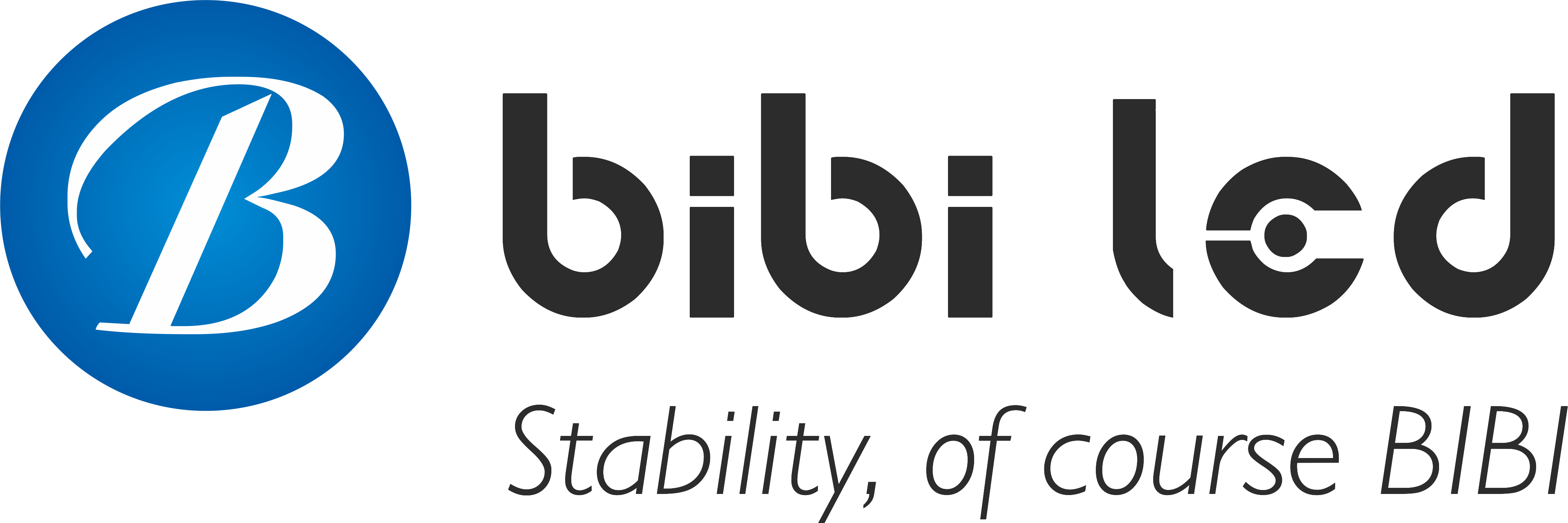序章
How can small brands stand out in a highly competitive market? LED表示画面 may be an unexpected weapon for you.
With high 輝度、 dynamic effects and flexible customisation, LED screens can not only quickly attract attention but also effectively strengthen brand image.
This article will take you to explore how small brands can cleverly use LED screens to create their own “visual dominance”.
目次
1. Unique advantages of LED display screens
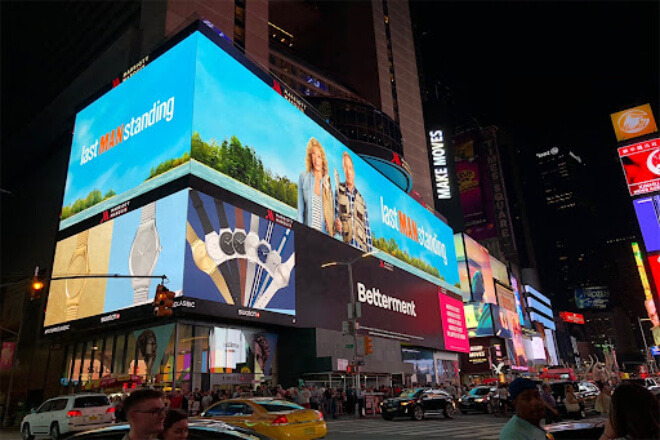
The most intuitive advantage of LED display screens is “brightness”. Even outdoors in direct sunlight at noon.
The picture is still clear and colourful, without the “white” and “foggy” problems of traditional screens.
Coupled with high-definition 解決, even if the font is small and the picture is complex, it can be seen clearly at a glance.
In this way, whether you are advertising, showing event previews, or showing brand stories, it can make people’s eyes shine.
For merchants, this visual advantage of “being able to see from a distance” is simply a free drainage artefact.
LED screens are very flexible in customisation, unlike TVs or traditional screens that have fixed sizes.
It can be spliced piece by piece, as big as you want, curved, vertical, hollow, or even shaped.
For example, some brands advertise around pillars, some museums use irregular LEDs to make immersive exhibition halls, and some retail stores directly turn windows into “luminous walls”.
In short, the bolder your space is, the more dazzling it can be with you.
LED display screens are not just a “film player”. Its greatest charm lies in the fact that the content can move and can be interactive.
It can play animations and videos, run real-time weather and crowd data, and even combine sensors to achieve interactive experiences such as “lights turn on when people come” and “manually change screens”.
This method is particularly suitable for use in retail stores, exhibition sites or brand flash events.
It has a sense of technology and can attract people to stay for a few more seconds. For brands, these few seconds may determine conversion.
2. How to use LED screens to attract attention
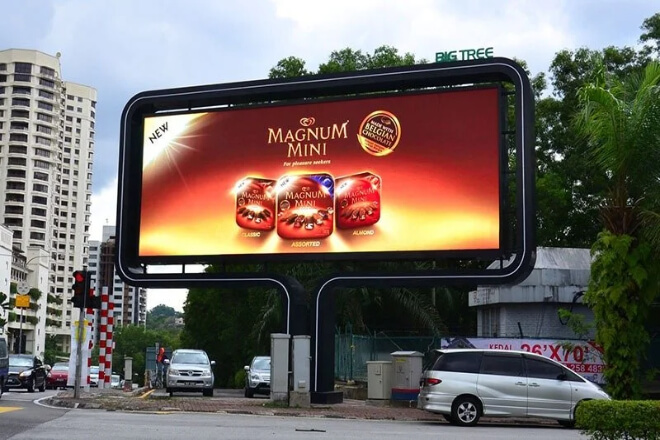
1). Use of colour and contrast:
The brightness of LED screens is beyond doubt, but if the colour matching is messy, the audience will not only not look at it more, but may also skip it directly.
A key point is “contrast”: for example, dark background + highlighted text, the information stands out immediately, clean and neat, especially suitable for displaying key content.
Another example is using the brand’s main colour to unify the picture style, which can not only enhance the aesthetics but also enhance brand memory.
Don’t pile up all colours; it looks like a palette at first glance. That kind of “dazzle” is not attractive, but dissuading.
Remember one sentence: clear contrast, information will not be drowned.
2). Use dynamic images to enhance attractiveness:
In an information-intensive business environment, static things are easily overlooked, and dynamic images are the weapon to “catch the eye”.
One of the advantages of LED screens is that they can play smooth videos, motion effects and switching animations.
For example, short videos, word-by-word scrolling titles, and visual beats with a strong sense of rhythm can make people unable to help but watch for two seconds.
But the motion effect should have a sense of rhythm, not too fast or too fancy; otherwise, it will be like yelling at you, not attracting you.
Proper white space and timely pauses will make the picture feel breathable and more advanced.
3). Design strategy to stimulate the senses:
A good LED screen is not only “good-looking”, but also can make people “feel” a certain emotion or atmosphere.
For example, the screen of the cafe uses warm tones and a slowly drifting steam animation to make people relax all of a sudden.
And the trendy brand store uses strong rhythm changes and mirror reflection visual elements to make people feel that they have entered an “attitude space”.
If the venue conditions permit, you can also synchronise with multiple sensory elements such as music, lighting, and smell.
The LED screen is no longer just an information display tool, but a part of the overall experience, making it easier for people to immerse themselves in it and remember you.
3. How does the LED screen strengthen the brand image
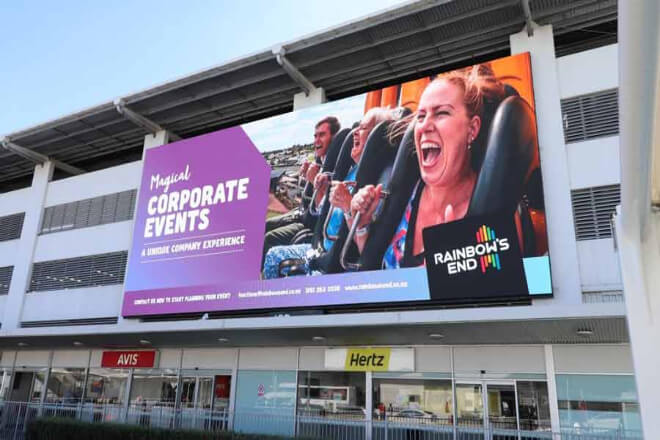
1). Display of brand colours and logos:
The high brightness and accurate colour reproduction ability of the LED display make it easier for brand colours and LOGOs to “go viral”.
Don’t underestimate the uniformity of this colour. In many cases, consumers remember not a slogan, but the familiar blue, red and green.
The advantage of LED screens is that they can not only display logos and slogans, but also use colours more boldly and in a more layered way, strengthening visual anchor points.
Even if it is only a few seconds of exposure, as long as the brand elements are output steadily, they can “occupy a place” in people’s hearts over time.
2). Vivid presentation of brand stories:
Brand stories are not just about “who we are”, but also about making people want to see and remember them.
LED screens provide a platform for storytelling – you can use dynamic videos, illustrations, animations.
And a combination of pictures and texts to make a brand journey, a founder’s experience, and a user experience vivid and interesting.
For example, the American outdoor brand Patagonia is particularly good at telling stories.
In their flagship store in New York, there is a large LED screen that keeps playing a short film called “Worn Wear”.
This tells the real experience of customers wearing the same jacket over mountains and hills, using it for more than ten years, and still not wanting to throw it away.
These pictures look like documentaries, but they are all real stories. At the same time, you are shopping in the store.
You hear people telling their stories about this jacket, which feels like listening to old friends chatting, and you immediately have a good impression of this brand.
Paper flyers can’t express this feeling at all; only LED screens can make it “alive” like this.
3). Customised content enhances brand personality:
Every brand wants to be different, and LED screens can help you “customise your expression”.
Not everyone has to use bright red and green to promote sales, and not every screen has to be colourful to be attractive.
Some brands are suitable for minimalist style, while others are suitable for trendy and dynamic styles. As long as the content is tailored for the brand, it will have personality and recognition.
You might as well try to use LED screens to display “brand calendars”, customer check-in walls, user UGC dynamics…
These contents are combined with scenes and cultural atmosphere. The closer they are to the brand’s temperament, the more they can resonate, and the easier it is for people to like and trust them.
4. How small brands can effectively use LED screens to increase exposure
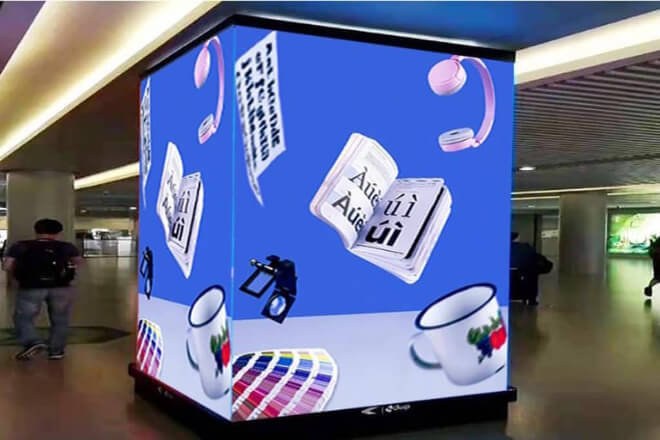
1). Reasonably choose the installation location of the LED screen:
For small brands, the budget is not much, and LED screens cannot be “laid”, but they must be “placed cleverly”.
Don’t think about the places with the largest traffic at the beginning – those locations are also expensive.
A smarter approach is to choose a location that is related to your target customer group, has no visual obstruction, and has a relatively long stay time.
For example, community entrances, office building lobbies, elevator entrances, and even brand store windows.
It is not that the more people see you, the better, but that the “right people” are more likely to notice you. If the location is well chosen, the exposure value will double.
2). Frequency and strategy of content updates:
LED screens are not just installed and done. What really leaves an impression is the continuous output of content.
Small brands can create a “sense of expectation” by regularly updating the screen content.
Even if you change a slogan or a product picture every week, people will think that you are a vibrant and warm brand. More importantly, the content strategy should be grounded.
For example, combining with holiday hotspots, user feedback, and even surrounding community dynamics will be more attractive than the same product pictures.
3). Content customisation for precise target audiences:
Small brands do not need to advertise “widely”. The most suitable way to use LED screens is targeted communication.
First, figure out who you want to attract – young people? Moms? White-collar workers?
Then customise the screen content according to their language habits, aesthetic preferences, and topics of concern.
For example, for white-collar workers, you can display lunch break packages and afternoon tea discounts; for young people, you can focus on “punching in” and visual style.
The mothers may be more concerned about practicality, health, and security. As long as the content of the screen hits their needs, they will naturally be willing to stop and watch you.
5. How is the cost-effectiveness and return on investment?
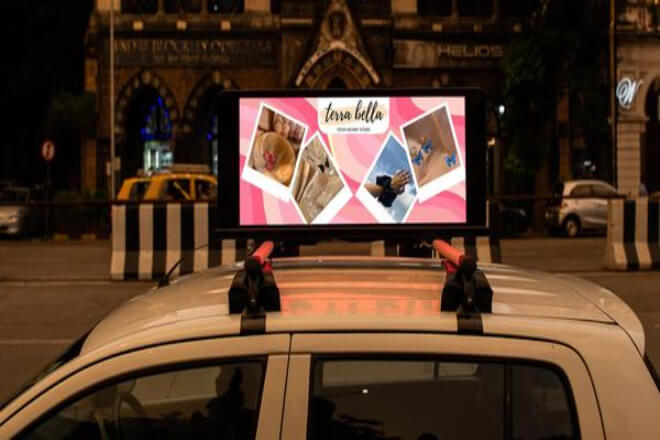
1). LED screen cost and small brand budget matching strategy:
Many small brands think LED screens are “expensive” when they hear about them. In fact, LED technology is now popular, and the price is much more affordable than in the past.
Especially small-sized, window-style, rental or spliced LED screens are more suitable for brands with limited budgets.
The key is not to blindly pursue large screens with high configurations, but to configure them according to actual needs.
For example, if you only display product information, you don’t have to use ultra-high resolution.
Indoor screens do not require so much brightness. A reasonable selection of size, type, brightness, and control system can actually achieve a “low-cost screen”, and the effect is still outstanding.
2). Return on investment analysis:
Although LED screens are not an “instant effect” advertising method, the “brand presence” they bring is long-term and effective.
When customers can see your brand information in a fixed scene every day, even if they don’t consume immediately, they will form an impression in their subconscious.
Especially when the content strategically guides actions, such as “scan the code to receive coupons”, “limited time discounts”, “check in at the store to get gifts”, the conversion rate can be quantified.
After installing screens at the door, many small brands have seen an increase in customer retention rate, higher store entry rate, and even an increase in customer unit price – this is the return.
3). Long-term benefits and continued attention increase:
The real value of LED screens is not just short-term exposure, but more like a “brand spokesperson” who is online 24 hours a day and does not need to rest.
Especially when the content is updated properly, the visual style is unified, and the information is clearly delivered, it can repeatedly strengthen brand memory.
For small brands, it is particularly important to establish a sense of trust and familiarity, and LED screens are one of the tools to do this.
Even if you don’t have a budget for advertising at the moment, you can use it to continuously convey brand warmth, launch new products.
And tell stories, accumulating little by little, and eventually forming a stable attention and reputation.
6. 結論
Brand sense does not necessarily need to be fanfare. Sometimes, the more low-key it is, the more touching it is. Can your tea room also become a gentle narrator of brand stories?
Why not start with a small LED screen, so that employees can feel the company’s care and warmth every time they pour water?
最後に、LEDディスプレイスクリーンについてさらに詳しく知りたい場合は、 ご連絡ください。
